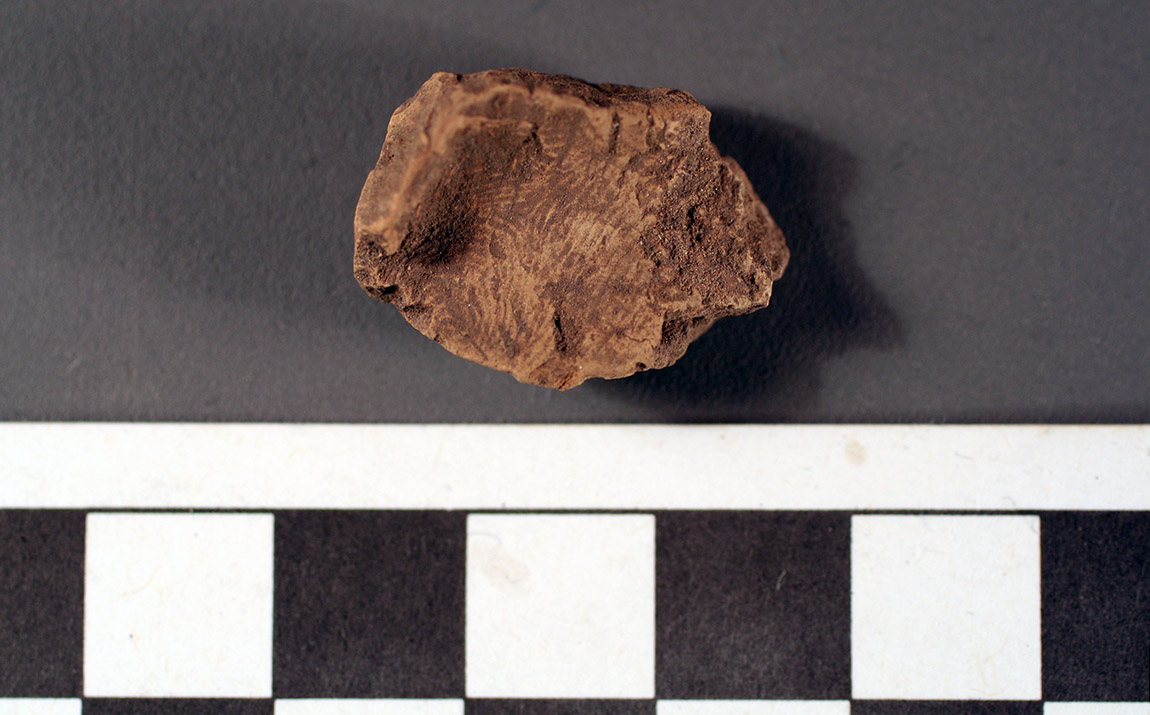
Michelle Rathgaber, ARAS-Parkin Research Station
Artifact of the Month - March 2020
This piece of daub is fairly small, only measuring about 2cm x 1.5cm, but what it preserves is remarkable (Figure 1). There is a fingerprint of the person who applied this piece of daub impressed on its surface. Although we will never know exactly who that person was, seeing a fingerprint is a great reminder that archeology helps us to learn about the people who made and used the things that we excavate, not just the things themselves.

This piece of daub was excavated at the Richard’s Bridge site (3CT11/22) during the Summer Training Program in 2015 by members of the Arkansas Archeological Society. In fact, because we keep extensive records during excavation, I can tell you that Dan Sharp and Sam Mater excavated it from 10–20cm below the ground surface in a context that was mixed due to plowing. This means that we cannot precisely tie this piece of daub to a particular building, but it was definitely from this village. We also cannot give it a precise date, but we know that the site generally dates to the Mississippi period.
So what is daub? Daub is made from silt, clay, grasses, sticks, and water mixed together to form a thick, sticky clay-like substance that was used to cover house walls at Mississippian sites in northeast Arkansas (in this case, the Richard’s Bridge site) (Figure 2). Houses were built by putting posts into the ground and then splitting cane and running it between the posts to form walls. We can see evidence of the posts archeologically through post molds discovered in carefully excavated contexts. We often don’t see the actual wood used for the posts, or any of the other building materials, because it decays in the wet soils of the Delta region. So how do we know the cane and posts were there? We look at the daub (Figure 3). Daub was pressed onto the walls to seal them against wind and drafts. This means that impressions of the wall posts and split cane are left on the side of the daub that was pressed against them.


The daub that we find on archeological sites has not decayed because, much like pottery, it has been fired. This firing happened when a house caught fire and burned down. The difference between daub and pottery is that pottery vessels are made from clay that has been mixed with a tempering material such as shell to keep it from shrinking too quickly and therefore cracking during firing. Daub does not contain this tempering material, so it breaks apart as it is heated and leaves chunks of various sizes where the house once stood for archeologists to find. In addition to firing the daub, the fire also burns the cane and logs used to build the house walls and the grasses, leaves, and sticks that were mixed into the daub to help it hold onto the wall. This leaves archeologists with chunks of burned daub with holes and impressions that can help us learn about the materials and techniques used to construct these Mississippian houses (Figure 4). Ethnobotanists can sometimes identify some of the grasses and other materials in the daub by the impressions that were left. And even without exact identification archeologists can see the various sizes and shapes of materials that were incorporated into the daub or used as part of the wall that the daub was pressed against.
We don’t always give daub a lot of credit as an important or interesting artifact, but if you know what to look for and look carefully enough, you can sometimes find out very interesting things.
 Collections and items in our institution have incomplete, inaccurate, and/or missing attribution. We are using this notice to clearly identify this material so that it can be updated, or corrected by communities of origin. Our institution is committed to collaboration and partnerships to address this problem of incorrect or missing attribution. For more information, visit localcontexts.org.
Collections and items in our institution have incomplete, inaccurate, and/or missing attribution. We are using this notice to clearly identify this material so that it can be updated, or corrected by communities of origin. Our institution is committed to collaboration and partnerships to address this problem of incorrect or missing attribution. For more information, visit localcontexts.org.
 The Arkansas Archeological Survey is committed to the development of new modes of collaboration, engagement, and partnership with Indigenous peoples for the care and stewardship of past and future heritage collections.
The Arkansas Archeological Survey is committed to the development of new modes of collaboration, engagement, and partnership with Indigenous peoples for the care and stewardship of past and future heritage collections.
 The TK Notice is a visible notification that there are accompanying cultural rights and responsibilities that need further attention for any future sharing and use of this material. The TK Notice may indicate that TK Labels are in development and their implementation is being negotiated. For more information about the TK Notice, visit localcontexts.org.
The TK Notice is a visible notification that there are accompanying cultural rights and responsibilities that need further attention for any future sharing and use of this material. The TK Notice may indicate that TK Labels are in development and their implementation is being negotiated. For more information about the TK Notice, visit localcontexts.org.
